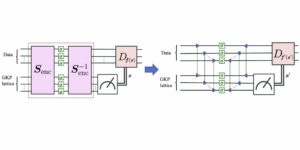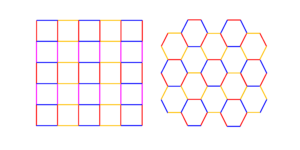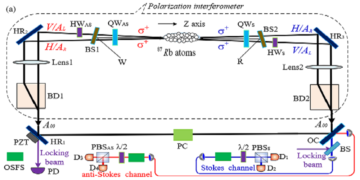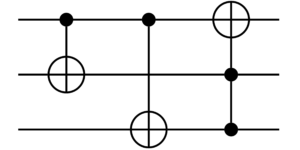1QC Ware, Palo Alto, USA and Paris, France
2IRIF, CNRS – University of Paris, France
3Indian Institute of Technology Roorkee, India
4F. Hoffmann La Roche AG
Find this paper interesting or want to discuss? Scite or leave a comment on SciRate.
Abstract
Quantum machine learning techniques have been proposed as a way to potentially enhance performance in machine learning applications.
In this paper, we introduce two new quantum methods for neural networks. The first one is a quantum orthogonal neural network, which is based on a quantum pyramidal circuit as the building block for implementing orthogonal matrix multiplication. We provide an efficient way for training such orthogonal neural networks; novel algorithms are detailed for both classical and quantum hardware, where both are proven to scale asymptotically better than previously known training algorithms.
The second method is quantum-assisted neural networks, where a quantum computer is used to perform inner product estimation for inference and training of classical neural networks.
We then present extensive experiments applied to medical image classification tasks using current state of the art quantum hardware, where we compare different quantum methods with classical ones, on both real quantum hardware and simulators. Our results show that quantum and classical neural networks generates similar level of accuracy, supporting the promise that quantum methods can be useful in solving visual tasks, given the advent of better quantum hardware.
► BibTeX data
► References
[1] Aram W Harrow, Avinatan Hassidim, and Seth Lloyd. “Quantum algorithm for linear systems of equations”. Physical review letters 103, 150502 (2009).
https://doi.org/10.1103/PhysRevLett.103.150502
[2] Seth Lloyd, Masoud Mohseni, and Patrick Rebentrost. “Quantum algorithms for supervised and unsupervised machine learning” (2013).
[3] Seth Lloyd, Masoud Mohseni, and Patrick Rebentrost. “Quantum principal component analysis”. Nature Physics 10, 631–633 (2014).
https://doi.org/10.1038/nphys3029
[4] Iordanis Kerenidis and Anupam Prakash. “Quantum recommendation systems”. 8th Innovations in Theoretical Computer Science Conference (ITCS 2017) 67, 49:1–49:21 (2017). url: doi.org/10.48550/arXiv.1603.08675.
https://doi.org/10.48550/arXiv.1603.08675
[5] Iordanis Kerenidis, Jonas Landman, Alessandro Luongo, and Anupam Prakash. “q-means: A quantum algorithm for unsupervised machine learning”. In Advances in Neural Information Processing Systems 32. Pages 4136–4146. Curran Associates, Inc. (2019). url:.
arXiv:1812.03584
[6] Seth Lloyd, Silvano Garnerone, and Paolo Zanardi. “Quantum algorithms for topological and geometric analysis of data”. Nature communications 7, 1–7 (2016). url: doi.org/10.1038/ncomms10138.
https://doi.org/10.1038/ncomms10138
[7] Edward Farhi and Hartmut Neven. “Classification with quantum neural networks on near term processors” (2018). url: doi.org/10.48550/arXiv.1802.06002.
https://doi.org/10.48550/arXiv.1802.06002
[8] I Kerenidis, J Landman, and A Prakash. “Quantum algorithms for deep convolutional neural networks”. EIGHTH INTERNATIONAL CONFERENCE ON LEARNING REPRESENTATIONS ICLR (2019).
https://doi.org/10.48550/arXiv.1911.01117
[9] J Allcock, CY Hsieh, I Kerenidis, and S Zhang. “Quantum algorithms for feedforward neural networks”. ACM Transactions on Quantum Computing 1 (1), 1-24 (2020).
https://doi.org/10.1145/3411466
[10] Iris Cong, Soonwon Choi, and Mikhail D. Lukin. “Quantum convolutional neural networks”. Nature Physics 15 (2019).
https://doi.org/10.1038/s41567-019-0648-8
[11] Hector Ivan Garcıa-Hernandez, Raymundo Torres-Ruiz, and Guo-Hua Sun. “Image classification via quantum machine learning” (2020). url: doi.org/10.48550/arXiv.2011.02831.
https://doi.org/10.48550/arXiv.2011.02831
[12] Saurabh Kumar, Siddharth Dangwal, and Debanjan Bhowmik. “Supervised learning using a dressed quantum network with “super compressed encoding”: Algorithm and quantum-hardware-based implementation” (2020). url: doi.org/10.48550/arXiv.2007.10242.
https://doi.org/10.48550/arXiv.2007.10242
[13] Kouhei Nakaji and Naoki Yamamoto. “Quantum semi-supervised generative adversarial network for enhanced data classification” (2020). url: doi.org/10.1038/s41598-021-98933-6.
https://doi.org/10.1038/s41598-021-98933-6
[14] William Cappelletti, Rebecca Erbanni, and Joaquín Keller. “Polyadic quantum classifier” (2020). url: doi.org/10.48550/arXiv.2007.14044.
https://doi.org/10.48550/arXiv.2007.14044
[15] Vojtech Havlicek, Antonio D. Córcoles, Kristan Temme, Aram W. Harrow, Abhinav Kandala, Jerry M. Chow, and Jay M. Gambetta. “Supervised learning with quantum enhanced feature spaces” (2018). url: doi.org/10.1038/s41586-019-0980-2.
https://doi.org/10.1038/s41586-019-0980-2
[16] Edward Grant, Marcello Benedetti, Shuxiang Cao, Andrew Hallam, Joshua Lockhart, Vid Stojevic, Andrew G. Green, and Simone Severini. “Hierarchical quantum classifiers” (2018). url: doi.org/10.1038/s41534-018-0116-9.
https://doi.org/10.1038/s41534-018-0116-9
[17] Bobak Toussi Kiani, Agnes Villanyi, and Seth Lloyd. “Quantum medical imaging algorithms” (2020). url: doi.org/10.48550/arXiv.2004.02036.
https://doi.org/10.48550/arXiv.2004.02036
[18] Marco Cerezo, Andrew Arrasmith, Ryan Babbush, Simon C Benjamin, Suguru Endo, Keisuke Fujii, Jarrod R McClean, Kosuke Mitarai, Xiao Yuan, Lukasz Cincio, et al. “Variational quantum algorithms” (2020). url: doi.org/10.1038/s42254-021-00348-9.
https://doi.org/10.1038/s42254-021-00348-9
[19] Kishor Bharti, Alba Cervera-Lierta, Thi Ha Kyaw, Tobias Haug, Sumner Alperin-Lea, Abhinav Anand, Matthias Degroote, Hermanni Heimonen, Jakob S Kottmann, Tim Menke, et al. “Noisy intermediate-scale quantum algorithms”. Reviews of Modern Physics 94, 015004 (2022). url: doi.org/10.1103/RevModPhys.94.015004.
https://doi.org/10.1103/RevModPhys.94.015004
[20] Monique Noirhomme-Fraiture and Paula Brito. “Far beyond the classical data models: symbolic data analysis”. Statistical Analysis and Data Mining: the ASA Data Science Journal 4, 157–170 (2011). url: doi.org/10.1002/sam.10112.
https://doi.org/10.1002/sam.10112
[21] Adrián Pérez-Salinas, Alba Cervera-Lierta, Elies Gil-Fuster, and José I Latorre. “Data re-uploading for a universal quantum classifier”. Quantum 4, 226 (2020). url: doi.org/10.22331/q-2020-02-06-226.
https://doi.org/10.22331/q-2020-02-06-226
[22] Kosuke Mitarai, Makoto Negoro, Masahiro Kitagawa, and Keisuke Fujii. “Quantum circuit learning”. Physical Review A 98, 032309 (2018).
https://doi.org/10.1103/PhysRevA.98.032309
[23] Maria Schuld, Ville Bergholm, Christian Gogolin, Josh Izaac, and Nathan Killoran. “Evaluating analytic gradients on quantum hardware”. Physical Review A 99, 032331 (2019).
https://doi.org/10.1103/PhysRevA.99.032331
[24] Maria Schuld and Francesco Petruccione. “Quantum models as kernel methods”. In Machine Learning with Quantum Computers. Pages 217–245. Springer (2021).
[25] Maria Schuld, Ryan Sweke, and Johannes Jakob Meyer. “Effect of data encoding on the expressive power of variational quantum-machine-learning models”. Physical Review A 103, 032430 (2021).
https://doi.org/10.1103/PhysRevA.103.032430
[26] Iris Cong, Soonwon Choi, and Mikhail D Lukin. “Quantum convolutional neural networks”. Nature Physics 15, 1273–1278 (2019).
[27] Jarrod R McClean, Sergio Boixo, Vadim N Smelyanskiy, Ryan Babbush, and Hartmut Neven. “Barren plateaus in quantum neural network training landscapes”. Nature communications 9, 1–6 (2018). url: doi.org/10.1038/s41467-018-07090-4.
https://doi.org/10.1038/s41467-018-07090-4
[28] Carlos Ortiz Marrero, Mária Kieferová, and Nathan Wiebe. “Entanglement-induced barren plateaus”. PRX Quantum 2, 040316 (2021). url: doi.org/10.1103/PRXQuantum.2.040316.
https://doi.org/10.1103/PRXQuantum.2.040316
[29] Marco Cerezo, Akira Sone, Tyler Volkoff, Lukasz Cincio, and Patrick J Coles. “Cost function dependent barren plateaus in shallow parametrized quantum circuits”. Nature communications 12, 1–12 (2021). url: doi.org/10.1038/s41467-021-21728-w.
https://doi.org/10.1038/s41467-021-21728-w
[30] Kunal Sharma, Marco Cerezo, Lukasz Cincio, and Patrick J Coles. “Trainability of dissipative perceptron-based quantum neural networks”. Physical Review Letters 128, 180505 (2022). url: doi.org/10.1103/PhysRevLett.128.180505.
https://doi.org/10.1103/PhysRevLett.128.180505
[31] S Johri, S Debnath, A Mocherla, A Singh, A Prakash, J Kim, and I Kerenidis. “Nearest centroid classification on a trapped ion quantum computer” (2021).
[32] Kui Jia, Shuai Li, Yuxin Wen, Tongliang Liu, and Dacheng Tao. “Orthogonal deep neural networks”. IEEE transactions on pattern analysis and machine intelligence (2019).
https://doi.org/10.1109/TPAMI.2019.2948352
[33] Jiayun Wang, Yubei Chen, Rudrasis Chakraborty, and Stella X Yu. “Orthogonal convolutional neural networks”. In Proceedings of the IEEE/CVF Conference on Computer Vision and Pattern Recognition. Pages 11505–11515. (2020).
https://doi.org/10.1109/CVPR42600.2020.01152
[34] Nitin Bansal, Xiaohan Chen, and Zhangyang Wang. “Can we gain more from orthogonality regularizations in training deep networks?”. Advances in Neural Information Processing Systems 31 (2018).
https://doi.org/10.5555/3327144.3327339
[35] Xiaohua Zhai, Alexander Kolesnikov, Neil Houlsby, and Lucas Beyer. “Scaling vision transformers” (2021).
[36] Iordanis Kerenidis and Anupam Prakash. “Quantum machine learning with subspace states” (2022). url: doi.org/10.48550/arXiv.2202.00054.
https://doi.org/10.48550/arXiv.2202.00054
[37] Sergi Ramos-Calderer, Adrián Pérez-Salinas, Diego García-Martín, Carlos Bravo-Prieto, Jorge Cortada, Jordi Planagumà, and José I. Latorre. “Quantum unary approach to option pricing” (2019).
https://doi.org/10.1103/PhysRevA.103.032414
[38] Nikodem Grzesiak, Reinhold Blümel, Kenneth Wright, Kristin M. Beck, Neal C. Pisenti, Ming Li, Vandiver Chaplin, Jason M. Amini, Shantanu Debnath, Jwo-Sy Chen, and Yunseong Nam. “Efficient arbitrary simultaneously entangling gates on a trapped-ion quantum computer”. Nat Commun, 11 (2020).
https://doi.org/10.1038/s41467-020-16790-9
[39] Alexander Zlokapa, Hartmut Neven, and Seth Lloyd. “A quantum algorithm for training wide and deep classical neural networks” (2021). url: doi.org/10.48550/arXiv.2107.09200.
https://doi.org/10.48550/arXiv.2107.09200
[40] Mario Lezcano-Casado and David Martınez-Rubio. “Cheap orthogonal constraints in neural networks: A simple parametrization of the orthogonal and unitary group”. In International Conference on Machine Learning. Pages 3794–3803. PMLR (2019). url: doi.org/10.48550/arXiv.1901.08428.
https://doi.org/10.48550/arXiv.1901.08428
[41] Moshe Leshno, Vladimir Ya Lin, Allan Pinkus, and Shimon Schocken. “Multilayer feedforward networks with a nonpolynomial activation function can approximate any function”. Neural networks 6, 861–867 (1993).
https://doi.org/10.1016/S0893-6080(05)80131-5
[42] Robert Hecht-Nielsen. “Theory of the backpropagation neural network”. In Neural networks for perception. Pages 65–93. Elsevier (1992).
https://doi.org/10.1109/IJCNN.1989.118638
[43] Raul Rojas. “The backpropagation algorithm”. In Neural networks. Pages 149–182. Springer (1996).
https://doi.org/10.1007/978-3-642-61068-4_7
[44] Jiancheng Yang, Rui Shi, and Bingbing Ni. “Medmnist classification decathlon: A lightweight automl benchmark for medical image analysis” (2020).
https://doi.org/10.1109/ISBI48211.2021.9434062
[45] Daniel S. Kermany, Michael Goldbaum, and et al. “Identifying medical diagnoses and treatable diseases by image-based deep learning”. Cell, vol. 172, no. 5, pp. 1122 – 1131.e9, (2018).
https://doi.org/10.1016/j.cell.2018.02.010
[46] Ping Zhang and Bin Sheng. “Deepdr diabetic retinopathy image dataset (deepdrid), “the 2nd diabetic retinopathy – grading and image quality estimation challenge””. https://isbi.deepdr.org/data.html (2020).
https://isbi.deepdr.org/data.html~
[47] Hyeonwoo Noh, Tackgeun You, Jonghwan Mun, and Bohyung Han. “Regularizing deep neural networks by noise: Its interpretation and optimization”. NeurIPS (2017).
https://doi.org/10.5555/3295222.3295264
[48] Xue Ying. “An overview of overfitting and its solutions”. In Journal of physics: Conference series. Volume 1168, page 022022. IOP Publishing (2019).
https://doi.org/10.1088/1742-6596/1168/2/022022
[49] El Amine Cherrat, Iordanis Kerenidis, Natansh Mathur, Jonas Landman, Martin Strahm, and Yun Yvonna Li. “Quantum vision transformers” (2022).
[50] Scott Aaronson. “Read the fine print”. Nature Physics 11, 291–293 (2015).
https://doi.org/10.1038/nphys3272
[51] Michael A. Nielsen. “Neural networks and deep learning”. Determination Press (2015).
Cited by
This Paper is published in Quantum under the Creative Commons Attribution 4.0 International (CC BY 4.0) license. Copyright remains with the original copyright holders such as the authors or their institutions.









